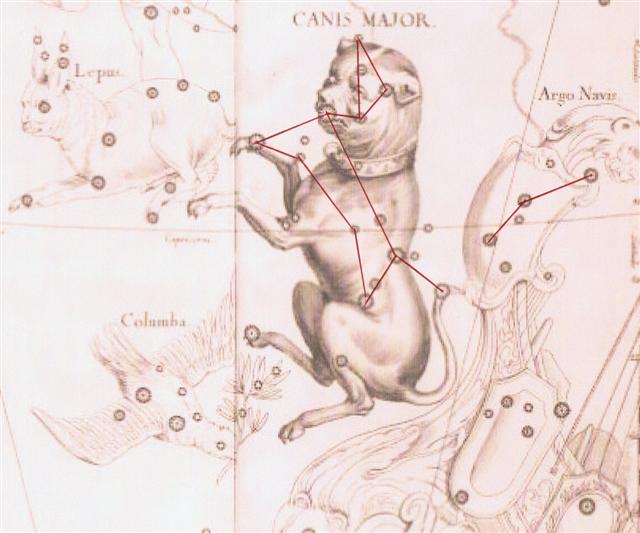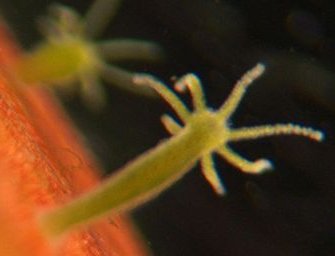The henua calendar (as I have named it) perhaps is beginning with Bright Fire (Ga3-2):
At the time of G the π glyph Ga3-14 should have coincided with 9h and August 5. From equinox to the manzil date Murzim 1 there are 136 days (*136 at Ga3-13). The Gregorian calendar is beginning 136 days earlier than the manzil calendar and therefore its day number is 216, i.e. 136 + 80 = 216. March 21 is day 80 in the Gregorian calendar but in the manzil calendar day 80 is Murzim 1. The manzil calendar is beginning with Sheratan 1 in May 17 (137). Murzim is another name for the star Mirzam (β Canis Majoris), which was rising heliacally together with Canopus ca 40 days earlier than the manzil date Murzim 1. In the illustration below the star Mirzam (Murzim) has been drawn at the right front paw of the Great Dog (Canis Major). The brightest star in the night sky is Sirius, at the nose of the Great Dog and at Ga2-7:
At the time of G the 'nose' rose heliacally 5 weeks earlier than Murzim 1, i.e. 101 days beyond equinox and in day number 181 according to the Gregorian calendar. The 'nose' presumably refers to the position at the beginning of the 2nd wheel of the solar 'bicycle'. The right front paw of the Great Dog - at the beginning of line a2 - rose in St John's Day or 6 days earlier than Sirius:
In the drawings of Hevelius time is running from left to right, just as in the rongorongo texts. "Murzim, generally but less correctly, Mirzam, and occasionally Mirza, is from Al Murzim¹, the Announcer, often combined by the Arabs with β Canis Minoris in the plural Al Mirzamāni, or as Al Mirzamā al Shi'rayain, the two Sirian Announcers ... ¹ Literally the Roarer, and so another of the many words in the Arabic tongue for the lion, of which that people boasted of having four hundred." (Allen) The maitaki ('good') glyph type in Ga3-17 comes 20 weeks after equinox. Although 3-17 seems to allude to the position 31 weeks. 140 + 77 = 217 and equal to the day number for August 5. At the time of G the Nose of the Lion (Al Minhar al Asad) was rising in August 10, in day 222 of the Gregorian calendar:
Line a3 is the shortest among the 16 on the tablet. Ga3-24 is positioned at the 227th day of the Gregorian calendar - and this number can allude to π (by the approximation 22 / 7). Counted from the beginning of the manzil calendar Ga3-24 coincides with day 91 (= 364 / 4). Counted from equinox Ga3-24 is located in day 84 + 63 = 147 (= 21 weeks). There are 16 dots around haś in Ga3-22. 472 / 16 = 29½. Possibly we are meant to go back to the triplet of glyphs beginning with Ga2-24. Also haś in Ga2-23 has 16 marks:
145.4 (Ukdah, ι Hydrae) - 117.4 (Azmidiske) = 28.0 and Ukdah means 'the Knot': ... σ, 4.6, was Ulug Beg's Al Minhar al Shujā', the Snake's Nose. τ¹, 4.9, flushed white, and τ², 4.6, lilac, with ι and the 5th magnitude A, form the curve in the neck, Ptolemy's Καμπή; but Kazwini knew them as Ukdah, the Knot ... 
From August 13 to the end of the Gregorian year there are 365 - 225 = 140 days (20 weeks). The Hydra constellation is far south and possibly this watery snake cannot be killed and has to be stopped by a noose around its neck: "Biologists are especially interested in Hydra due to their regenerative ability; and that they appear not to age or to die of old age." (Wikipedia)
Possibly the firmly drawn and rather strange Ga2-29 is meant to represent a hydra:
| ||||||||||||||||||||||||||||||||||||||||||||||||||||||||||||||||||||||||||||||||||||||||||||||||||||||||||||||||||||||||||||||||||||||||||||||||||||||||||||||||||||||||||||||||||||||||||||||||||||||||||||||||||||||||||||||||||||||||























